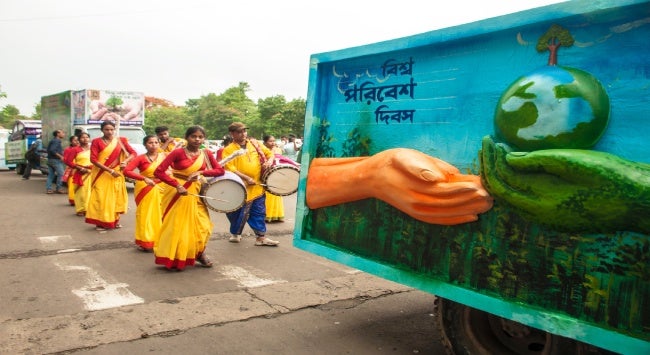Summary
India’s climate diplomacy is deeply shaped and constrained by intensifying geopolitical and security competition between the United States and China that is changing how and where India discusses climate and energy issues.
India’s climate diplomacy has evolved from a defensive posture centred on equity and development to a more proactive, strategic and multifaceted approach that aligns environmental goals with economic and geopolitical priorities. Historically, India framed its engagement through the principle of common but differentiated responsibilities (CBDR), arguing that the developed countries had the primary responsibility for reducing carbon emissions. This position continues to guide India’s stance at the Conference of the Parties (COP) discussions, but its use has become far more pragmatic and opportunistic. The sharpening United States (US)-China rivalry has fractured multilateral climate cooperation further affecting how India behaves on climate change globally that now manifests in four ways.
First, India will increasingly have to balance climate responsibilities between different blocs given shifting interests. It will it partner with the US and the broader West on clean energy through the Quadrilateral Security Dialogue’s (Quad) climate and technology initiatives and the US-India Clean Energy 2030 partnership but also cooperate with China and the developing countries under the Brazil, South Africa, India, China bloc and Group of 77+China coalition to defend principles of equity and the CBDR. This balance will likely sustain for New Delhi as it strives to align with the developed countries for green finance and technology while standing solidly with the developing countries to deflect and jettison incommensurate climate commitments while advocating for climate justice considerations.
Second, India’s climate diplomacy intersects with economic security concerns, especially given the need to secure supply chains for critical minerals, solar components and batteries. Going forward, India’s decarbonisation diplomacy will increasingly reflect an effort to diversify from Chinese-dominated green supply chains given security considerations. Further engagement with initiatives like the India-European Union Trade and Technology Council will only aim to build secure and reliable ecosystems for green technology and raw materials. India’s diplomacy will become both climate-oriented and strategic, where the energy transition is tied to industrial policy, investment security, and technological autonomy.
Third, the climate-security nexus will likely define India’s engagement with its partners. Increasingly, issues like energy security, water security and infrastructure protection are strategic priorities tied to national security. Therefore, diplomacy will also focus on matters related to climate adaptation, resilience and disaster risk reduction as climate events rise and precipitate internal migration, displacement, resource extraction and competition. As a result, forums like the International Solar Alliance (ISA) and Coalition for Disaster Resilient Infrastructure (CDRI) that serve as institutions to advance climate resilience will grow in value. Both the ISA and the CDRI have attracted wide membership and financing, projecting India as a provider of public goods and a convener of climate initiatives. These platforms have enhanced India’s credibility, especially among the developing countries seeking practical solutions for adaptation and renewable energy.
Fourth, the hollowing out of traditional climate multilateralism will have cascading effects on how states refocus their climate diplomacy, possibly favouring greater engagement through minilateral and regional frameworks. India’s experience exemplifies this trend. India advances climate cooperation through selective partnerships (such as the Quad, the Indo-Pacific Economic Framework for Prosperity and the ISA) that align with its strategic interests, rather than relying solely on the United Nations (UN) Framework Convention on Climate Change process. This agility enables India to exercise agency in shaping rules and financing norms outside UN agencies and processes while still participating at the COPs. This approach will likely persist. This way, India effectively positions itself as a bridge between the industrialised and developing worlds, advocating for energy transitions that are just, affordable and nationally determined.
Security competition has affected and will affect India’s climate diplomacy. It has already made India’s climate engagements more strategic, selective and pragmatic. India’s domestic commitments reinforce this external posture. Targets like achieving 450 gigawatts of renewable energy by 2030 and reaching net zero by 2070 form the core of its climate agenda. And India still faces constraints in climate finance mobilisation, technology transfer and balancing development with emissions reduction. Moreover, geopolitical tensions and energy security priorities sometimes slow deeper cooperation.
Yet, as geopolitical competition intensifies, India’s climate diplomacy inflects with concerns over energy security, technology access and supply-chain resilience. India will champion equity and development rights but now frames these ideas and positions through the language of resilience, sovereignty and technology partnerships. India’s climate diplomacy is no longer just about emissions targets but shaping the geopolitics of decarbonisation in a fractious world. India’s climate diplomacy today reflects a synthesis of traditional multilateralism and pragmatic minilateralism. It will endorse and advance climate justice while pursuing partnerships that strengthen its economic sovereignty and technological capacity, allowing it to navigate the intersection of climate action, development and great-power competition.
. . . . .
Dr Karthik Nachiappan is a Research Fellow at the Institute of South Asian Studies (ISAS), an autonomous research institute at the National University of Singapore (NUS). He can be contacted at isaskn@nus.edu.sg. The author bears full responsibility for the facts cited and opinions expressed in this paper.
Pic Credit: ISAS
-
 More From :
More From :
-
 Tags :
Tags :
-
 Download PDF
Download PDF



